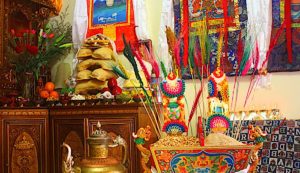The study of the five classical texts is divided into fourteen classes. Based on seniority, the classes are ranked as:
- Class 1
- Class 2
- Class 3
- Zenkyang
- The senior Madhyamika
- The junior Madhyamika
- The supplementary class of Prajnaparamita called Zurkhol
- Prajnaparamita forth
- Prajnaparamita third
- Prajnaparamita second
- Senior to old Prajnaparamita
- Old Prajnaparamita
- New Prajnaparamita
- The Art of Logical Reasoning, and The Combined Class of Tenets, Seventy Aspects of the Path, Paths and Grounds [Dupdhonsasum]
With Maitreya’s Ornament of Clear Realization- which covers the whole range of teachings on the Prajnaparamita- as basis, for seven years students of Prajnaparamita study the four other texts of Maitreya, The Two Distinguishers, Haribadra’s Commentary That Illuminates The Meaning, Tsongkhapa’s A Precious Excellent Instruction Called The Golden Chain, Gyaltsab Je’s Ornament To The Essence of Explicit Explanation, Khedrup Je’s Light On The Difficult Points, the root text and commentaries on the topic of Basic Consciousness As The Foundation Of All [Kunshi Namshe], Tsongkhapa’s An Excellent Instruction Called The Essence [lekshed Nyinpo]On The Art Of Skillfully Distinguishing Between The Definite And The Interpretable, and all of Khedrup Tendarwa’s writings on Prajnaparamita.
With Chandrakirti’s root text Engaging in the Middle as the basis, the students of Madhyamika study The Six Collections on the ‘Middle Way’ by Nagarjuna, the root text and commentary of The Hundred [Verses] by Aryadeva Illuminating the Words of ‘the Middle’ by Chandrakirti, Tsongkhapa’s five main texts on the philosophical views[], Thousand Doses that Open the Eyes of Fortunate Beings by Khedrup Je Gelek Pelsangpo, Gyaltsab Je’s commentary on Shantideva’s Engaging in the Deeds of Boddhisattvas, and Khedrup Tendarwa’s General Presentation and Critical Analysis on Madhyamika.
When the students are in the class of Zenkyang, they study the classical treatises of Vinaya. With Sharchen Ngawang Tsultrim’s Summary of Vinaya’ as the basis, students study the Root and Auto-Commentary of Sutra on Self-Liberation, Extensive Commentary of Vinaya, Great Commentary by Kunkhen Tsonawa, the First Dalai Lama Gyalwa Gedun Drupa’s Precious Rosary, Panchen Lodoe Leksang’s General Presentation and Explanation of Vinaya Treatise.
The second class and Lharampa class study Abhidharma and its auto-commentary by Vasubandhu, Chim Jampelyang’s text on Abhidharma, and Gyalwang Thinley Namgyal’s A Sun-Like Extensive Commentary that Illuminates Darkness. Pramana, the art of reasoning in Buddhism, is studied in the beginners’ class of Preliminary Logic, the class of Mind System, the class of Rational Reasoning, and is further continued for two months every year, with the second month always coinciding with the dates of winter Jang Gunchoe Debate Sessions held amidst the monk scholars of all the great monasteries.

Through rigorous debate sessions, memorizations, recitations, lectures, and personal readings, students are trained to explore the depth and expanse of Buddhist teachings, enabling them to understand the whole mainstream of Buddhism and difficult points within it.
In the monastic tradition of the major seats such as Sera and Drepung, students study by receiving teachings on classical treatises, by memorizing and reciting them, and through engaging in contemplation and debate. Annually, the monastery has eight great debate sessions, each of which lasts for a month or more. Except on special public holidays, the Great Maitreya Prayer Session and the Great Medicinal Buddha Prayer Session, students always attend debate classes.
1. A commentary on Engaging in the Middle called ‘Explicit Illumination the Thoughts,
2. The Great Commentary to the Fundamental of Wisdom called the Ocean of Reasoning,
3. & 4. The two works within greater and smaller Lamrin on the Superior Insight [Vipassana],
5. The Excellent Instruction called the essence of the art of skillfully distinguishing between the interpretable and definite.
sessions were occasionally held in order to accumulate merits for the success of the study and also as part of the practice of purification.
Unlike other modern universities or centers, any sincere aspirants who wish to pursue his monastic education can do so without worrying over any financial constraint. Foreigners should have the obligatory PAP [protected area permit from the Indian govt.









